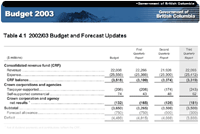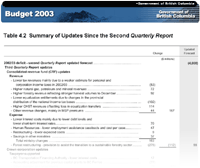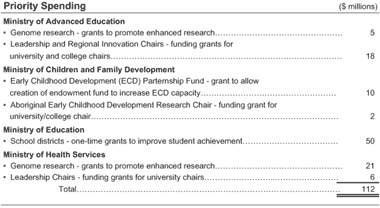 |
|
The deficit forecast for 2002/03 has improved by $200 million from the second Quarterly Report forecast. At $3.8 billion, the deficit which includes a $300 million forecast allowance for potential negative developments over the rest of the year, is now projected to be $600 million lower than forecast in the February 19, 2002 budget. Excluding forecast allowances, the updated deficit forecast would be $3.5 billion, $150 million less than the comparable budget forecast of $3.65 billion. Chart 4.1 Progress of 2002/03 financial forecasts
Since the second Quarterly Report in November:
Table 4.2 provides details on developments since the second Quarterly Report. RevenueThe revenue forecast is $167 million higher than the second Quarterly Report. Significant changes include:
Further details on the full year revenue forecast are shown in Table 4.7 and key assumptions are provided in Appendix Table A.11.
|
||||||||||||||||||||||||||||||||||||||||||||||||||||||||||||||||||||||||||||||||||||||||||||||||||||||||||||||||||||||||||||||||||||||||||||||||||||||||||||||||||||||||||||||||||||||||
| |
|
|
Table 4.3 Consolidated Revenue Fund — 2002/03 |
|
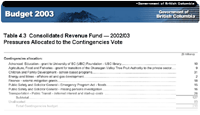 |
|
A total of $127 million has been allocated to the Contingencies Vote, leaving $83 million available to address other spending pressures over the rest of the year. Further details on the spending forecasts are shown in Table 4.8 and assumptions are provided in Appendix Table A12.
Crown Corporations and Agencies
Crown corporation and agency net losses are projected to be $55 million higher than the second Quarterly Report. Significant changes include:
- BC Transportation Financing Authority (BCTFA) — a $17 million decrease in net loss reflects lower interest costs due to lower-than-expected interest rates and lower-than-anticipated borrowing reflecting higher fuel tax revenue.
- Accounting adjustment — a $77 million one-time negative adjustment to BC Ferries' asset values. Previously, an adjustment was made to reflect capital grants to the corporation from the CRF1. Effective March 31, 2003, this adjustment will be reversed as BC Ferries' assets are being transferred to the new independent, regulated operating company.
- British Columbia Railway Company — a $30 million increase in BC Rail's net losses for 2002 is due to further restructuring costs. However, this loss will be offset by a $30 million gain on the anticipated sale of selected BC Marine assets in the first quarter of the 2003 calendar year (the last quarter of government's fiscal year).
- Insurance Corporation of British Columbia (ICBC) — a projected $18 million increase in net income for 2002 reflects higher premium revenue and lower claims and related costs.
|
|
|
| 1 | The The grants were used to reduce the capital cost of the ferries in BC Ferries' financial statements. However, on consolidation the grants are eliminated and the assets are recorded at their original capital costs on government's balance sheet. |
Further details on the Crown corporation forecasts are shown in Table 4.9.
Chart 4.2 Changes to 2002/03 Budget Forecast

2002/03 Fiscal Year Review
Since the February 19, 2002 budget, revenue, spending and Crown corporation forecasts have, in aggregate, stayed close to or ahead of budget as significant changes to individual elements have largely offset each other.
The forecast for income tax revenues fell significantly as assessment reports for the 2001 tax year were received from the federal government. The lower-than-forecast estimates of 2001 personal and corporation income tax revenues reduce the tax base for 2002 and subsequent years. The estimated impact in 2002/03 was a $768 million loss in income tax revenues. This loss was more than offset by increases in other revenue sources, primarily equalization transfers and natural resources.
Overall government spending is now projected to be $144 million below budget. Excluding the provision for forestry restructuring, spending for the year would have been $419 million below budget due to lower debt interest costs, lower-than-assumed employment assistance caseloads, and below-budget spending in various ministries.
Crown corporation net losses are forecast to be $49 million higher than the February 19, 2002 budget. Taxpayer-supported Crown corporation net losses are forecast to be $37 million higher than budget, primarily due to accounting adjustments resulting from the restructuring of BC Ferries, partially offset by improved operating results for the BCTFA.
Commercial Crown corporation net results were $12 million lower than anticipated as an accounting policy change for BC Hydro led to higher contributions paid to the CRF. This was partially offset by improved operating results for ICBC. The deterioration in BC Rail's results during the January-to-March period was included in the province's 2001/02 financial statements. As well, a gain on sale of selected BC Marine assets is expected in the first quarter of 2003. Therefore, the reported losses are offset by an accounting adjustment that reflects BC Rail's net results during the province's fiscal year.
Capital Spending and Provincial Debt
Since the second Quarterly Report, the capital spending forecast has been lowered $268 million to total $2.2 billion. Significant changes are shown in Table 4.5.
In total, capital spending for the year is $551 million below the February 19, 2002 budget mainly due to lower spending for health and education facilities, ministry minor capital purchases, the SkyTrain extension project and ICBC's Surrey Central City project.
| |
|
|
Table 4.4 2002/03 Budget and Forecast Updates — |
|
 |
|
Further details on capital spending are shown in Table 4.10. Information on updated forecasts for major capital projects (those with multi-year budgets totalling $50 million or more) is provided in Table 4.11.
Provincial debt is forecast to total $37.3 billion at year-end. The forecast is $1.64 billion lower than the second Quarterly Report due to an improved CRF deficit forecast, lower capital spending, timing differences between accrued spending and cash payments, lower working capital requirements and a lower debt forecast allowance mirroring the deficit forecast allowance (see Table 4.5). The decreased forecast continues a trend which saw the debt forecast decline by $1.82 billion as of the second Quarterly Report. Total debt is now forecast to be $3.46 billion below budget.
Further information on the debt forecast is shown in Table 4.12.
| |
|
|
Table 4.5 Summary of Updates Since the Second |
|
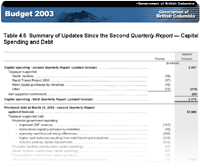 |
|
| |
|
|
Table 4.6 Updated Forecast |
|
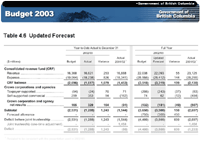 |
|
| |
|
|
Table 4.7 Consolidated Revenue Fund Revenue by Source |
|
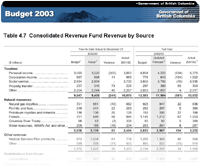 |
|
| |
|
|
Table 4.8 Consolidated Revenue Fund Expense by Ministry |
|
 |
|
| |
|
|
Table 4.9 Crown Corporation and Agency Updated Forecast |
|
 |
|
| |
|
|
Table 4.10 Capital Spending |
|
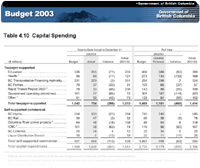 |
|
| |
|
|
Table 4.11 Capital Expenditure Projects |
|
 |
|
| |
|
|
Table 4.12 Provincial Debt |
|
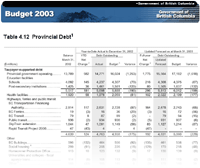 |
|
| |
|
|
Table 4.13 Statement of Financial Position |
|
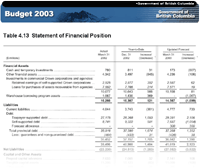 |
|
| |
|
|
Changes in Financial Position |
|
 |
|
 |
||||
| |
|
|||
